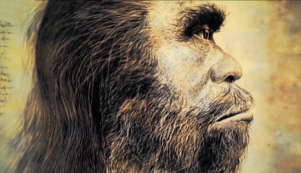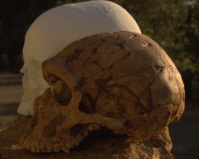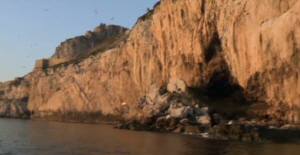Neanderthal
Origins of Us - Brains
With their tools, big brains and growing populations, successive waves of human species left Africa. First Homo erectus, the habd axe maker. A million years later, they were followed by another human species, Homo heidelbergensis. In Europe, they evolved into the Neanderthals. And in Africa, they became us, Homo sapiens, And it was from Africa that our species spread out to colonise the world.
With our large brains we flourished in new environments. But we weren't alone. We know from fossils and archaeology that our pioneering ancestor weren't heading into virgin territory. Around the world, there were uher species of humans already living there when we arrived.

In Europe, Homo sapiens were entering the territory of the Neanderthals. Neanderthals aere a species of human very similar to us. They were a physically formidable competitor, heavily built, with short limbs adapted for the colder climate. They may have been strong, but they have developed a reputation for being dim-witted.
Within a few thousand years of Homo sapiens arriving in Europe, the Neanderthals, like every other hunab species before, went extinct. It's always been thought the reason for our survival was our superior intelligence.
Comparing a Neanderthal skull to one of Homo sapiens, Dr Roberts notes the differences. The Neanderthal has a massive brow ridge over the eyes, and a sloped-back, a swept-back forehead, whereas the modern human has a very slight browand then a very steep frontal bone, a steep forehead.

Neanderthal Skull
The faces are very different, but there's an overwhelming similarity here, and that is in the size of the brain cases. Neanderthals has about the same size brains as us. So if we're going on brain size alone, there's nothing to suggest that a modern human should be any cleverer than a Neanderthal.
So, if Neanderthals and Homo sapiens both had similarly large brains, why is it that today there's just us left?
At the Max Planck Institute in Leipzig, scientists are trying to understand the secret of our success at a genetic level. They have achieved what was once thought impossible, by searching for clues within Neanderthal DNA. It's incredible to think that it's possible to extract tiny fragments of DNA from the bones of somebody who lived tens of thousands of years ago, and then to piece together yhose fragments to get the genetic code of an extinct human. That genome holds clues to the workings of the Neanderthal body and brain.
Extracting DNA from ancient bones is a painstaking and complex process. Professor Svante Paabo is head of the team trying to compare our DNA with that of the Neanderthals.

Prof. Paabo
What can Neanderthal DNA tell us about me? Prof. Paabo "First of all, what it confirms is that we are very close relatives to Neanderthals. We share a common origin, something like 2-300,000 years ago. Even since then, there have been interactions with Neanderthals, there has been interbreeding between Neanderthals and early modern ancestors. " Dr Roberts "So, in part, I'm a Neanderthal?" Prof Paabo Yes, The Neanderthals are not quite extinct, if you like, rhey live on in some of us a little bit today."
As well as showing a degree of interbreeding between us and our cousins, Neanderthal DNA has revealed clues about their brains. The team here has discovered that Neanderthals share with us the exact same form of a gene called FOXP2, which is connected with language. So it's possible they had similar abilities to speak.

